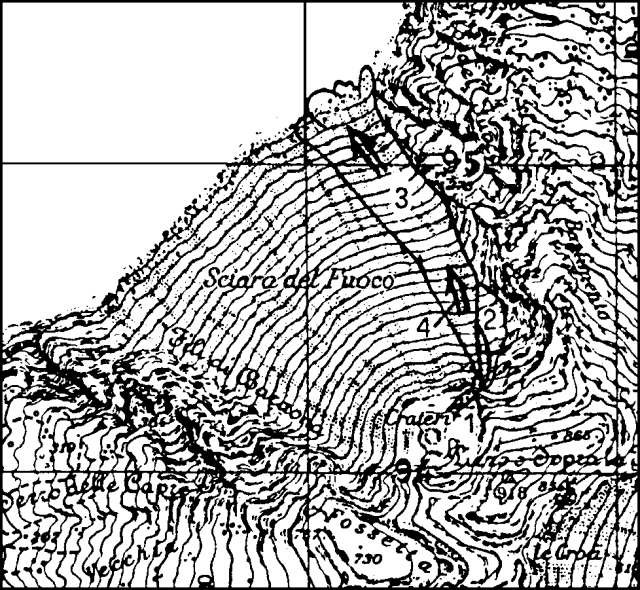Report on Stromboli (Italy) — January 1986
Scientific Event Alert Network Bulletin, vol. 11, no. 1 (January 1986)
Managing Editor: Lindsay McClelland.
Stromboli (Italy) Explosions and nuée ardente, then lava flow to sea
Please cite this report as:
Global Volcanism Program, 1986. Report on Stromboli (Italy) (McClelland, L., ed.). Scientific Event Alert Network Bulletin, 11:1. Smithsonian Institution. https://doi.org/10.5479/si.GVP.SEAN198601-211040
Stromboli
Italy
38.789°N, 15.213°E; summit elev. 924 m
All times are local (unless otherwise noted)
"On 6 December at 0745 an eruptive crisis with lava flow emission started at Stromboli, interrupting a 10-year period of persistent mild explosive activity during which liquid lava was constantly in the summit craters. Inception of the eruption was accompanied by a violent explosive phase and by the opening of a trough a few tens of meters wide on the NE margin of the crater platform. The newly formed eruptive trough, ~100 m long, developed from the easternmost vent of the main crater platform (825 m elevation) roughly NE down to an altitude of 680 m (figure 1). During the initial explosive phase, which lasted ~1.5 hours, ash clouds rich in steam rose to an altitude of 2,000-3,000 m. At about 0815, a small nuée ardente descended the NW flank's Sciara del Fuoco (near the Fili del Fuoco side), reaching the sea. The explosive activity was mainly confined to the newly formed trough, which was probably widened by ejection of abundant old and fumarolically altered material. The first emission of a lava flow was from a temporary vent a few tens of meters higher than the eventual main eruptive vent, preceding or accompanying the explosive phase. The first lava flow descended toward the easternmost edge of the Sciara, forming a small lava field (at the foot of Bastimento rock). Later that morning, the lava vent was displaced N to an elevation of ~680 m because of further collapse of the eruptive trough. From this point, a second lava flow started to descend the 40° steep slope of the Sciara del Fuoco, reaching the sea at about 1100.
"During the following days, the lava front advanced a few tens of meters into the sea, forming a small peninsula at the NE end of the Sciara del Fuoco. Advance of the lava flow into the sea was frequently accompanied by secondary phreatic explosions and strong steaming. The lateral drainage of the degassed lava was followed by a drop of the lava level in the upper craters, changing their activity from lava fountains (5 December) to rhythmic puffs of ash clouds and continuous steaming.
"A visit to the summit on 8 December revealed a thin ashfall cover containing millimeter-sized accretionary lapilli deposited during the initial phreatomagmatic explosive phase. Outpouring of lava continued through December and January, with an average decline in lava output and a tendency to accumulate materials on the E side of the Sciara del Fuoco. Lava was still emerging on 27 January.
"Preliminary seismic investigations (Biviano and others, 1985) indicated that no relevant variations occurred in the 3 months preceding the eruption. An isolated event (M >2.5) located a few kilometers below the volcano was recorded on 18 November, ~2 weeks before the eruption. Microseismicity related to the very shallow explosivity of the volcano revealed a weak tendency to increase as the eruption approached. Preliminary analysis of the lava emitted in the first few days of the eruption indicated that the rock is a silica undersaturated shoshonitic basalt (SiO2 49.5%, Ne 1.1), containing phenocrysts of olivine, clinopyroxene, and plagioclase very similar to those erupted in historic time at Stromboli.
"The 6 December phenomena and their precise timing were reconstructed from eyewitness observations and photographs. Field investigations were performed 7-14 December and 29 December-4 January by Rosi and Sbrana (Univ of Pisa) and Giovanni Frazzetta (IIV Catania). Preliminary information on seismicity was provided by G. Neri (IIV Catania) and extracted from Biviano and others, 1985. XRF analysis of major elements was performed at the Univ of Pisa.
References. Biviano, A., Di Prima, S., Falsaperla, S., Marturano, M., Neri, G., Pellegrino, A., and Velardita, S., 1985, Relazione informativa sull'attività sismica a Stromboli: internal report to the National Group of Volcanology, CNR.
Capaldi, G., Guerra, I., Lo Bascio, A., Luongo, G., Rapolla, A., Scarpa, R., del Pezzo, E., Martini, M., Ghiara, M. R., Lirer, L., Munno, R., and La Volpe, L., 1978, Stromboli and its 1975 eruption: BV, v. 41, p.259-285.
Further References. De Fino, M., La Volpe, L., Falsaperla, S., Frazzetta, G., Neri, G., Francalanci, L., Rosi, M., and Sbrana, A., 1988, The Stromboli eruption of December 6, 1985-April 25, 1986: volcanological, petrological and seismological data: Rendiconti della Società Italiana di Mineralogia e Petrologia, v. 43, p. 1,021-1,038.
Falsaperla, S., and Neri, G., 1986, Seismic monitoring of volcanoes: Stromboli (southern Italy): Periodico di Mineralogia, v. 55, p. 153-163.
Geological Summary. Spectacular incandescent nighttime explosions at Stromboli have long attracted visitors to the "Lighthouse of the Mediterranean" in the NE Aeolian Islands. This volcano has lent its name to the frequent mild explosive activity that has characterized its eruptions throughout much of historical time. The small island is the emergent summit of a volcano that grew in two main eruptive cycles, the last of which formed the western portion of the island. The Neostromboli eruptive period took place between about 13,000 and 5,000 years ago. The active summit vents are located at the head of the Sciara del Fuoco, a prominent scarp that formed about 5,000 years ago due to a series of slope failures which extends to below sea level. The modern volcano has been constructed within this scarp, which funnels pyroclastic ejecta and lava flows to the NW. Essentially continuous mild Strombolian explosions, sometimes accompanied by lava flows, have been recorded for more than a millennium.
Information Contacts: M. Rosi and A. Sbrana, Univ di Pisa.


